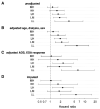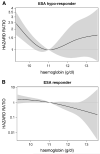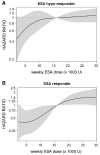Association of ESA hypo-responsiveness and haemoglobin variability with mortality in haemodialysis patients
- PMID: 20507852
- PMCID: PMC3360143
- DOI: 10.1093/ndt/gfq287
Association of ESA hypo-responsiveness and haemoglobin variability with mortality in haemodialysis patients
Abstract
Background: Anaemia is a common complication in dialysis patients. In most cases, it is treated with erythropoietin-stimulating agents (ESA). It is not entirely clear whether the variability of haemoglobin caused by changing ESA response is associated with increased mortality. Therefore, we conducted a retrospective cohort study to evaluate ESA responsiveness and haemoglobin variability in association with mortality.
Methods: We used the Austrian dialysis and transplant registry, and identified 932 patients who were on maintenance haemodialysis in the years 2005-08 with recorded weekly ESA doses and haemoglobin concentrations. ESA response was defined as a positive regression slope over the observation period. Cox regression analysis with spline functions and purposeful variable selection algorithms were used.
Results: Adjusted Cox regression analysis showed an increased mortality risk in subjects with wide ranges of haemoglobin variability (from <10 to >12 g/dL) (HR = 2.38, 95% CI 1.20-4.71, P = 0.013). Furthermore, patients that never reached haemoglobin levels >10 g/dL despite ESA therapy exhibited the highest risk of mortality (HR = 6.37, 95% CI 2.15-18.82, P < 0.001). ESA hypo-responsiveness was associated with increased risk of mortality in the low as well as high haemoglobin ranges [HR = 2.06, 95% CI 1.49-2.86 at haemoglobin of 9.5 g/dL and HR = 1.64, 95% CI 0.68-3.92 at 13.5 g/dL both vs. 11 g/dL (reference)]. ESA dose equivalents >16,000 units per week were associated with increased mortality in ESA responders (HR = 1.30, 95% CI 1.02-1.64). However, in hypo-responders, mortality is not associated with ESA dose (HR = 1.02, 95% CI 0.87-1.20) [both at weekly ESA dose of 20,000 units vs. 16,000 (reference)].
Conclusions: These findings suggest that the risk of mortality of haemodialysis patients requiring ESA therapy is lowest if the haemoglobin concentration is stably maintained in the range between 10 and 12 g/dL with weekly ESA dose equivalents <16,000 units.
Figures



References
-
- Fishbane S, Maesaka JK. Iron management in end-stage renal disease. Am J Kidney Dis. 1997;29:319–333. - PubMed
-
- Erslev AJ, Besarab A. Erythropoietin in the pathogenesis and treatment of the anemia of chronic renal failure. Kidney Int. 1997;51:622–630. - PubMed
-
- Macdougall IC. Optimizing the use of erythropoietic agents—pharmacokinetic and pharmacodynamic considerations. Nephrol Dial Transplant. 2002;17:66–70. - PubMed
-
- Macdougall IC, Robson R, Opatrna S, et al. Pharmacokinetics and pharmacodynamics of intravenous and subcutaneous continuous erythropoietin receptor activator (C.E.R.A.) in patients with chronic kidney disease. Clin J Am Soc Nephrol. 2006;1:1211–1215. - PubMed
-
- Besarab A, Bolton WK, Browne JK, et al. The effects of normal as compared with low hematocrit values in patients with cardiac disease who are receiving hemodialysis and epoetin. N Engl J Med. 1998;339:584–590. - PubMed
Publication types
MeSH terms
Substances
Grants and funding
LinkOut - more resources
Full Text Sources
Other Literature Sources
Medical

